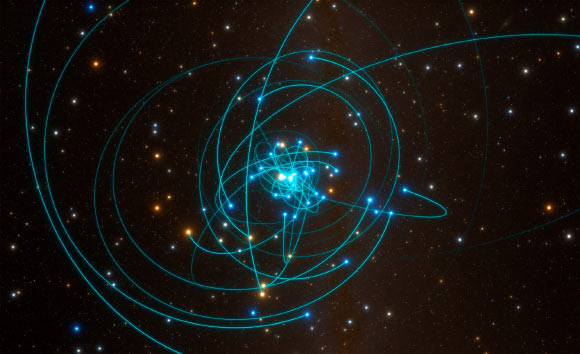Supermassive black holes are characterized by just two numbers: mass and spin, but have a critical influence on the formation and evolution of galaxies. The spin of Sagittarius A*, a 4-million-solar-mass black hole at the center of our Milky Way Galaxy, has been poorly constrained so far. In a new paper published in the Astrophysical Journal Letters, a team of U.S. astronomers placed an upper limit on the spin of Sagittarius A* based on the distribution of the S-stars in its vicinity.

Supermassive black holes at the cores of galaxies blast radiation and ultra-fast winds outward, as illustrated in this artist’s conception. Image credit: NASA / JPL-Caltech.
“Black holes release a huge amount of energy that removes gas from galaxies and therefore shapes their star formation history,” said Harvard University’s Professor Avi Loeb, co-author of the study.
“While scientists know that the mass of central black holes has a critical influence on their host galaxy, measuring the impact of their spin isn’t easy.”
“The effect of black hole spin on the orbits of nearby stars is subtle and difficult to measure directly.”
To get a better understanding of how Sagittarius A* has impacted formation and evolution of the Milky Way, Professor Loeb and his colleague, Dr. Giacomo Fragione from the Center for Interdisciplinary Exploration & Research in Astrophysics and Northwestern University, studied instead the stellar orbits and spatial distribution of the S-stars to place limits on the spin of the supermassive black hole.
“We concluded that the supermassive black hole in the center of our Galaxy is spinning slowly,” Dr. Fragione said.
“This can have major implications for the detectability of activity in the center of our galaxy and the future observations of the Event Horizon Telescope.”

This simulation shows the orbits of stars very close to Sagittarius A*, a supermassive black hole at the heart of the Milky Way. One of these stars, S2, orbits every 16 years and is passing very close to the black hole in May 2018. Image credit: ESO / L. Calçada / Spaceengine.org.
The S-stars appear to be organized into two preferred planes.
The authors showed that if Sagittarius A* had a significant spin, the preferred orbital planes of the stars at birth would become misaligned by the present time.
“For our study we used the recently-discovered S-stars to show that the spin of Sagittarius A* must be smaller than 10% of its maximal value, corresponding to a black hole spinning at the speed of light,” Professor Loeb said.
“Otherwise, the common orbital planes of these stars would not stay aligned during their lifetime, as seen today.”
The team’s results also point to another important detail about Sagittarius A*: it is unlikely to have a jet.
“Jets are thought to be powered by spinning black holes, which act as giant flywheels,” Professor Loeb said.
“Indeed there is no evidence of jet activity in Sagittarius A*,” Dr. Fragione added.
“Upcoming analysis of data from the Event Horizon Telescope will shed more light on this issue.”
_____
Giacomo Fragione & Abraham Loeb. 2020. An Upper Limit on the Spin of SgrA* Based on Stellar Orbits in Its Vicinity. ApJL 901, L32; doi: 10.3847/2041-8213/abb9b4







